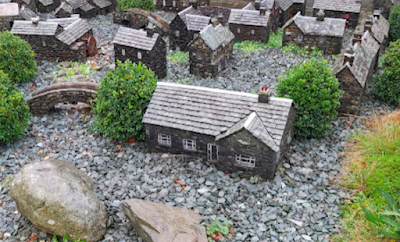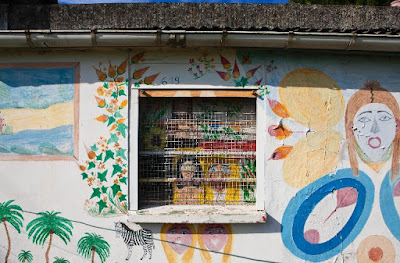 |
photos of the site by Bouvet Hubert published here with
permission of the Inventaire général du patrimoine Hauts de France
|
Henri Dalpez' decorated house and garden, depicted above, is located along a road just out Loos-en-Gohelle, a small town of some 7.000 inhabitants in the north of France, about 5 km north-west of the municipality of Lens, which has some 31.000 inhabitants.
The map below shows that Lens is located in the middle of an area referred to as Bassin Minier (Mining area) du Nord Pas-de-Calais.
 |
screenshot from the video "le Bassin Minier Nord Pas de Calais (YouTube, 2021, 5'13") by Lycée Saint-Cricq |
The coal industry, begun in the 1850s, turned the landscape in this part of Northern France into an industrial area with many large buildings and installations of mining companies, many uniform residential areas set up to house miners and their families, and numerous high, hill-shaped mounds of industrial waste.
In the 1980s coal mining was ended, which meant that the economy and employment of the area changed significantly and that many adjustments had to be made both on an individual and a collective level.
Life and works
Henri Delpaz was born in 1932. His parents had migrated from Spain to France, where his father had found work as an underground miner in Loos-en-Gohelle. The family lived in the house that Delpaz would later inherit and decorate.
In his early twenties Delpaz was drafted into military service to fight in France's war with Algeria (1954-1962). He then became an underground miner, and later established himself as an independent mason.
It is not known in which years in particular he was in the military and worked as a bricklayer. But it has been reported that in 1959, when he was in his late twenties, he started decorating the house in Loos-en-Gohelle, where he meanwhile lived. It may be that at that age he was already working as a bricklayer.
 |
the front side of the house, facing the street
|
Creating an art environment
The decorations in Dalpez' art environment include paintings on the exterior walls and small sculptures and other items in the area around the house.
The image above shows the entrance to the house, facing the street. The murals to the left and right of the window and the door show that Dalpez' work can be lighthearted, with pastoral scenes of animals in a green environment, probably in Africa, with zebras, lions and giraffes. The appearance of the lower part of the entrance door is in line with this.
The painting to the left of the door shows a tree trunk in front of a richly decorated shrub.
It's a special feature of this art environment that the windows of the house became part of Dalpez' creative project by filling these in with painted panels. In that way no one could see in, and vice versa, of course .....

The image above gives an impression of the decorations on the upper right side of the front wall of the house. Compared to the other decorations on the front of the house, these are much less atmospheric and illustrative, especially the images of human characters.
The faces that Dalpez painted on the wall often have open mouths, which may be intended to express happiness or surprise. Near the faces are also some numbers, the meaning of which is unknown (a referral to addresses along the street where Dalpez lived?).
The image of a ship in choppy water, at the left, brings back something of the atmosphere that radiates from the front of the house. Encased in a frame, it looks like a hung painting, but the image is painted directly onto the wall.
Another painted part of a side wall, as shown above, has because of the palms, the zebra and the foliage above, much more the atmosphere of the the lower part of the front wall at the entrance of the house.
The window in the middle is once more provided with a panel that closes the view. It is painted with two faces looking out through a grid of horizontal and vertical iron wires.
And once more there is a lady with an open mouth.
That open mouth, well, maybe Dalpez didn't have any explicit intention with it at all, maybe his way of designing was just how he saw people's faces.
This typical mouth is also present in a number of stand-alone sculptures which colorfully and rather expressive depict various personalities. With their lower bodies resting on a pole, they are arranged in the area around the house, one character guarding the mailbox.
Some sculptures have a number, but it is not known whether this refers to specific persons, just as there is no information available about who or what these sculptures could represent.
In June 2021, Sonia Terhzaz, a Paris-based author of a website with accounts of her visits and conversations with creators of art environments in France (see documentation) visited the site.
Henri Dalpez, now 89 years old, said he had not maintained his creation for several years, and that in his opinion the paintwork was quite ugly as a result. He couldn't understand why someone would come all the way from Paris to see this work and have a conversation with him.
The view of Dalpez's house on Google streetview, dating from September 2022, at the bottom of this post, shows that the decorations have somewhat faded over the years, but that it is still possible to get an impression of the artworks.
An uncertain future
In correspondence with the Inventaire général du patrimoine, conducted in late April 2023, it is noted that Henri Dalpez's house is no longer inhabited. Searching the local press for more information on this unfortunately had no results.
There is also no mention of activities aimed at preserving the site. There is a good chance that the decorations and small sculptures will be lost.
Then all that remains is the memory of a colorful creation, as reflected for example in the image below.
Documentation
* Article (2021), with a report of her visit to the site and meeting with Dalpez, by Sonia Terhzaz on her website
Cartographie des Rocamberlus, * Article in
l'Inventaire général du patrimoine des Hauts-de-France (general inventory of Hauts-de-France heritage)
Henri Dalpez
Decorated house and garden
569 Chemin des Croisettes
62750 Loos-en-Gohelle, dept Pas-de-Calais, region Hauts-de-France, France
can be seen from the street

























